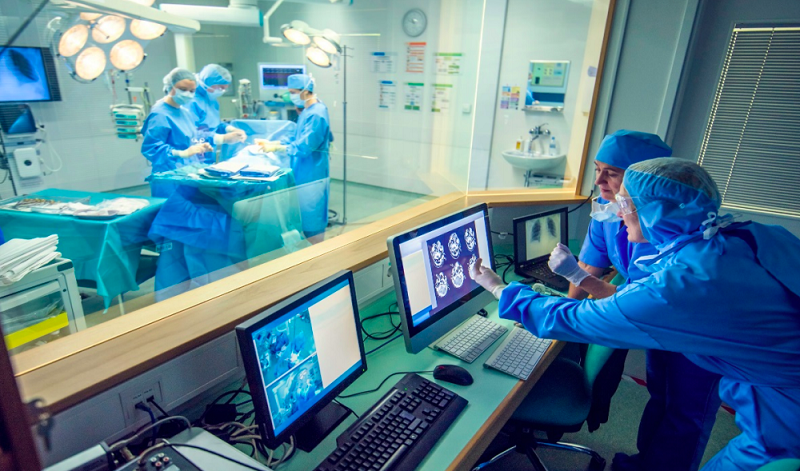There is always comfort to be taken from the existence of the NHS.
Whatever happens, you can be assured of the best-possible medical attention.
However, that service can be jeopardised by electrical outages.
And this isn’t a hypothetical situation. In August 2019, lightning strikes caused a major outage across large swathes of the UK, including at Ipswich Hospital after a battery failure caused the back-up generator to fail.
In the US, meanwhile, there are similar stories of hospitals and clinics that were unable to function after suffering outages caused by extreme weather events.
At a time when the healthcare sector is under more intense scrutiny than ever before, much attention has quite rightly been focused on the challenges faced by care workers and clinicians. But hospital infrastructure is no less important, yet rarely gets the attention it merits.
Digitisation is key to boosting resilience by enabling facilities managers to diagnose and prevent problems before they occur
So, it’s time to put electrical challenges facing hospitals, and their solutions, front and centre.
The always-on upgrade
One thing unites healthcare systems: they are running on fumes after almost two years of the most-profound public health crisis in a century.
The struggle of providing first-class care in the face of unprecedented demand has meant hospitals and trusts have had little time or budget to upgrade their electrical infrastructure.
And hospitals now face a raft of challenges; these include power disruptions, either because of a problem within the facility or the external supply; aging infrastructure which cannot be switched off and is therefore difficult to maintain; and a lack of full-time on-site expertise.
Added to these is the constant pressure to reduce carbon emissions in line with increasingly-strict government targets, such as the UK’s commitment to hit net zero emissions by 2040.
Hospitals, therefore, need to keep the lights, quite literally, on, as well as upgrade and update critical care equipment.
The only answer is to harness new technologies that enable healthcare facilities managers to analyse asset and power health in real time and to shift from a re-active to a pro-active mindset.

Digitisation is key to boosting resilience by enabling facilities managers to diagnose and prevent problems before they occur
Building resilience
Ask any doctor and they’ll tell you that prevention is always preferable to cure.
It’s the same for electricity infrastructure; building resilience into power systems is the best way to ensure hospitals do not suffer outages that can put patient lives at risk.
Digitisation is key to boosting resilience by enabling facilities managers to diagnose and prevent problems before they occur.
Meanwhile, technologies such as microgrids, power automation, power events analysis, and condition-based maintenance also play a major role in guarding against outages.
The struggle of providing first-class care in the face of unprecedented demand has meant hospitals and trusts have had little time or budget to upgrade their electrical infrastructure
Individual technologies all play their role in optimising resilience. However, the best results come when facilities centralise control of multiple connected devices in an IoT-enabled ‘system of systems’, such as an Emergency Power Supply System (EPSS).
Ideally, an EPSS will be built around a microgrid, which works by generating energy through distributed energy resources (DERs) such as renewables and combined heat and power (CHP) systems.
Hospitals already have many, if not most, of these connected power components in place.
This makes it relatively simple and cost effective to retrofit systems that combine them all underneath a single umbrella and enable them to analyse asset and power health across their estate.
Once they have this centralised visibility of the whole network, they gain a host of benefits.
For example, software analytics takes data from building management systems (BMS) and power distribution systems to notify you of common issues such as leaky valves, failing circuit breakers or, as with the Ipswich hospital example above, flat batteries.

Technologies such as microgrids, power automation, power events analysis, and condition-based maintenance also play a major role in guarding against outages which would put frontline health services at risk
This enables maintenance teams to address issues before they become a problem.
But, critical as it is to eliminate power interruptions, this isn’t the only benefit of centralised power management.
With many hospitals and trusts striving to reduce costs in the wake of the pandemic, digitisation can play a major role in reducing ongoing energy costs.
By monitoring systems all the way down to the device level, and running that data through cloud analytics, hospitals can identify previously invisible inefficiencies like IT hotspots or expiring batteries
By monitoring systems all the way down to the device level, and running that data through cloud analytics, hospitals can identify previously invisible inefficiencies like IT hotspots or expiring batteries.
And, by harnessing open-source, IoT-enabled energy management systems, hospitals can ensure they maintain the health of the energy infrastructure on which critical care depends.
